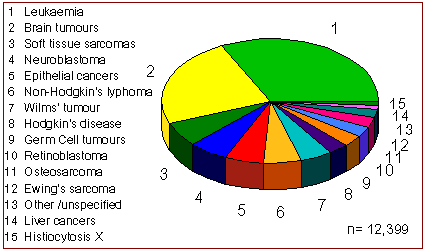
| © 1996-2003 |
Home |
| Site Map |
| Cancer Types |
| Treatments |
| Locations |
| Support & Information |
| Research |
| Health Professionals |
| About |
Disclaimer |
| About Childhood Cancer |
|
|
About Childhood CancerChildhood cancer is rare, about 1 in every 600 children develop cancer before the age of 15 - still relatively little is known about it's causes [1]. Childhood cancer is not a single disease - there are many different types. Compared with adult cancers they tend to have different histologies and occur in different sites of the body [2]. Common adult cancers such as lung, breast, colon, and stomach are extremely rare among children. On the other hand some types of cancer are almost exclusively found in children, especially embryonal tumours which arise from cells associated with the foetus, embryo, and developing body.The chart above shows the proportions of different types of childhood cancers - based on UK data from The National Registry of Childhood Tumours [3]. Leukaemia is the most common type of childhood cancer, representing about one third of all cancers in under 15 year olds. Leukaemia is a condition where too may underdeveloped white blood cells are found in the blood and bone marrow. Four fifths of childhood leukaemia's are acute lymphatic leukaemias (ALL), other types include acute myeloid leukaemia (AML) and chronic myeloid leukaemia (CML). Brain tumours are the most common solid tumours in childhood, and make up about a fifth of all children's cancers. There are many different types of brain tumours; medulloblastoma, astrocytoma and brainstem glioma are the most common. Neuroblastoma (sympathetic nervous system), retinoblastoma (eye), Wilms' tumour (kidneys), and hepatobalstoma (liver) are most usually found in infants or young children. Other malignancies found in children and young adults include Lymphomas (Hodgkin's and Non-Hodgkins Lymphoma), soft tissue sarcomas (including rhabdomyosarcoma), bone cancer (osteosarcoma and Ewing's sarcoma), plus a number of other less common childhood cancers. Histiocytocis is rare; it is not thought to be a true cancer, but in many respects behaves like one. The cause of most cancers remains unknown. A minority of cancers are known to be hereditary (inherited). For example some retinoblastomas, and Wilms' tumours are thought to be hereditary. In rare cases the family may have a history of cancers (Li-Fraumeni Syndrome) [4]. However most childhood cancers have no obvious hereditary cause. Children with cancer are generally treated by specialists. Medical professionals who have expertise in diagnosing and treating children with cancer include paediatric oncologists, pathologists, haematologists, radiotherapists, surgeons, radiographers, and others; all of whom work closely together, often in dedicated children's cancer centres. National and International children's cancer organisations have evolved in order to provide the best treatments, and are constantly engaged in research to further understand and develop better treatments for childhood cancer. The overall cure rate for childhood cancer has drastically improved over the last 2 decades in association with clinical trials and the development of new treatments [5,6]. References and information sources1. Stiller CA. Aetiology and epidemiology. In Plowman PN, Pinkerton CR, Paediatric Oncology: Clinical practice and controversies. Chapman and Hall Medical 1992. back to text 2. Miller RW, Young JL, Novakovic PH. Childhood Cancer. Cancer 1994;75:395-405. back to text 3. Stiller CA, Allen MB, Eatock EM. Childhood Cancer in Britain: The National Registry of Childhood Tumours and Incidence Rates 1978-1987. European Journal of Cancer 1995; 31A:2028-2034. back to text 4. Birch JM. Li-Frameni Syndrome. Eur. J. Cancer 1994;30A:1935-41. back to text 5. Lukens JN. Progress Resulting from Clinical Trials: Solid Tumours in Childhood Cancer. Cancer 1994;74:2710-8 back to text 6. Draper G, Kroll ME, Stiller C. Childhood Cancer. In: Trends in Cancer Incidence and Mortality. Cancer Surveys 1994;19,493-517. back to text |
| This page last updated: Sat 11 Jan 2003 | Home |

 Back to the Menu
Back to the Menu